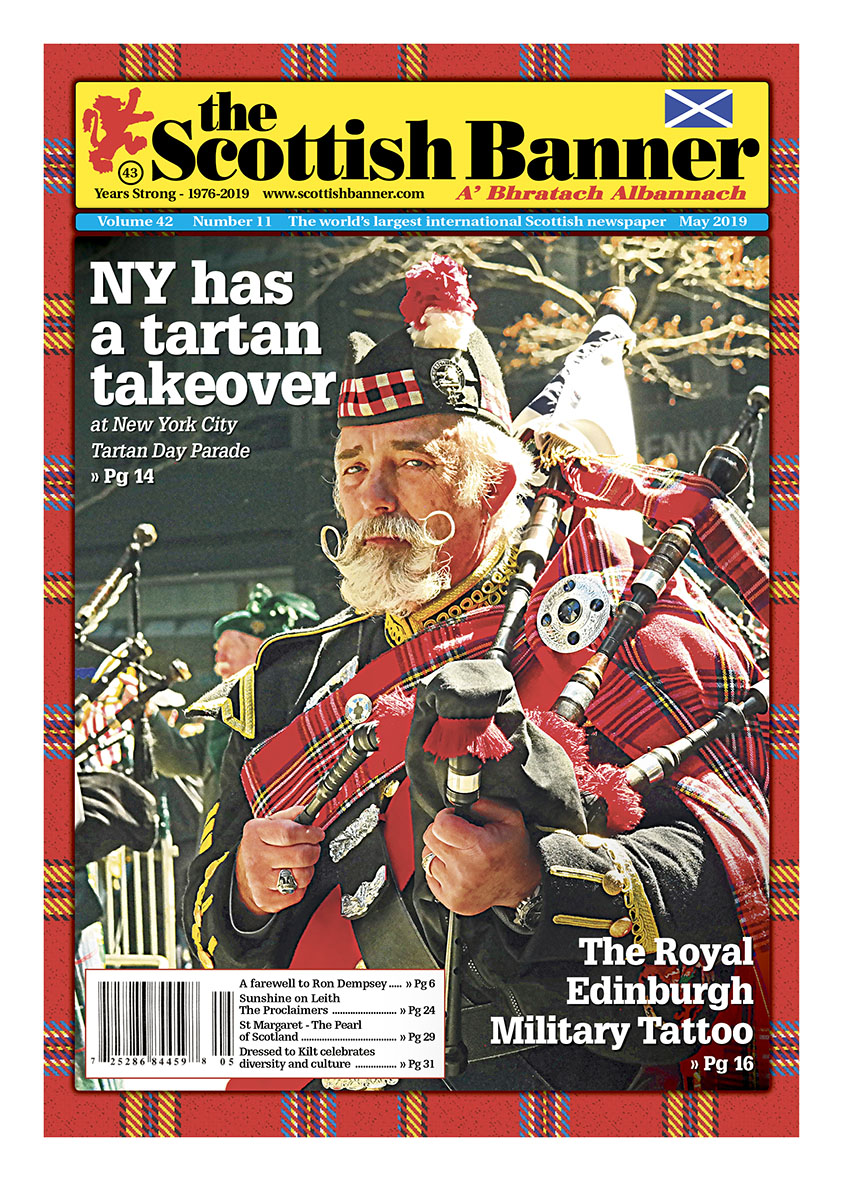May 2019 (Vol. 42, Number 11)
-

Gracing our front cover: The 2019 Tartan Day Parade in New York. Photo: Jennifer Leonard.
The Banner Says…
The changing flow of whisky
Think Scotland for many non- Scots and images of tartan, bagpipes and whisky come to mind. Scotland is all these things, and so much more, but those traditional icons often stand out for many. This month whisky will be highlighted both in Scotland and across the world as May hosts Whisky Month in Scotland and World Whisky Day also takes place globally.
Sold in over 200 countries worldwide, whisky is one of Scotland’s most famous exports, with nearly forty bottles of whisky being exported from Scotland every second! Last year that equated to nearly 558 million bottles, with recent big increases in the Indian and Chinese markets. This is on top of the already robust markets of Europe and the United States. A whisky can be called Scotch whisky only after it has matured for a minimum of three years in oak casks in Scotland itself. Over the years I have been asked about being ‘Scotch’ and I must let the person know that it is in fact a drink, not Scots.
It’s believed whisky-making began in Scotland as wine making methods spread from monasteries in Europe during the 11th century. Whisky which translates in Gaelic ‘uisge beathe’ (or ‘water of life’) is a product steeped in tradition, but at the same time one which is innovating itself in today’s modern world.
Ancient craft
The ancient craft of creating oak casks has been part of Scotch whisky for centuries, but the industry has celebrated a new first with the recruitment of two female coopering apprentices. First-year coopering apprentices Angela Cochrane and Kirsty Olychick – recruited by leading Scotch distiller Diageo at its Cambus Cooperage in Clackmannanshire – are breaking down the gender barriers and blazing a pioneering trail in the once male dominated trade.
Diageo has invested significantly in its coopering operations in Scotland in recent years, opening the £10 million state-of-the art Cambus Cooperage in 2011. Drawing on generations of skill and knowledge, and combining it with the state-of-the-art engineering, the cooperage is now able to process more whisky casks than ever before, producing over 400,000 casks each year to be used to mature spirit from Diageo’s portfolio of single grain and single malt distilleries.
The Spirit of Speyside Whisky Festival takes place this month in locations across Speyside, the spiritual home of Scotland’s whisky industry. One of the more unusual events is Secrets of Spynie on May 4 which combines walking and canoeing. During their guided journey by foot and by voyageur canoe, visitors will be able to learn about the 1,500-year history of the Laich of Moray where much of the barley used in local whisky is grown. Guides will also be sharing the story of Macbeth, the history of Spynie Canal and will visit Spynie Palace, which dates back to medieval times.
In this issue
Last month some prominent Scottish events took place around the world. We were thrilled to see Sir Billy Connolly take part in the New York Tartan Day events. It may be the Big Apple, but when the ‘Big Yin’ walks down the city streets in his kilt it was sure to make people stop and cheer. As our headline says, New York certainly had a tartan takeover.
The Royal Edinburgh Military Tattoo is one of the world’s top live events. Regular readers of the Scottish Banner will know of this event as we highlight the Tattoo on a regular basis with many readers having attended the Tattoo or most certainly have it on their bucket list. I was fortunate to sit down with Brigadier David Allfrey to hear about this great event and how it really is becoming an international viewing experience.
The Proclaimers are one of Scotland’s great music exports. They were certainly part of the soundtrack of my youth and over 30 years later they are still making great music and playing to audiences across the world. Craig Reid told me he was simply trying to get off the dole as he and twin brother Charlie formed the band back in the 80’s. Well they sure did that and made us all the richer for doing so.
Ron Dempsey
This month we say farewell to the longest contributor in Scottish Banner’s history Ron Dempsey. Many will know Ron from his What’s In A Name genealogy column. Ron has written for the Scottish Banner for over 30 years and provided much insight into people’s names and we hope has helped many people add that extra piece of information to their own family tree. Ron has always come up with a column when his mail bag is full, or empty, and his love of genealogy and helping others has come across in every column. To keep your content fresh and insightful for so long is no easy task, and I can think of few contributors who have been so loyal to the Scottish Banner and our readers.
I would like to thank Ron for his dedication and friendship to the Scottish Banner for all these years. I have known Ron since childhood and whilst the Banner will not be the same without him, I hope you will join me in wishing Ron all the very best for the future and if he has helped you or sparked your genealogy interest please share your story with us. Ron as you hang your keyboard up with us, I hope you can look back with pride on helping so many and most certainly helping the Scottish Banner grow to new heights one name at a time.
Do you have any comments on this month’s editorial or edition? Share your story with us by email, post, social media or at: www.scottishbanner.com/contact-us
